Samsung Tomorrow Marketing Report
VerifiedAdded on 2019/09/16
|29
|3919
|72
Report
AI Summary
This marketing report provides a detailed analysis of Samsung's marketing strategy for its Galaxy Tab, comparing it to competitors Apple and Xiaomi. The report covers company backgrounds, target market segmentation (geographic, demographic, psychographic, and behavioral), value proposition and positioning, pricing strategies (skimming, prestige, and penetration pricing), promotion strategies, and distribution channels. A perceptual map visually represents the competitive landscape, and the product life cycle stages of each brand are discussed. The report concludes with recommendations for Samsung to maintain its market leadership, emphasizing continuous innovation, improved battery capacity and storage, and a stronger online shopping experience.
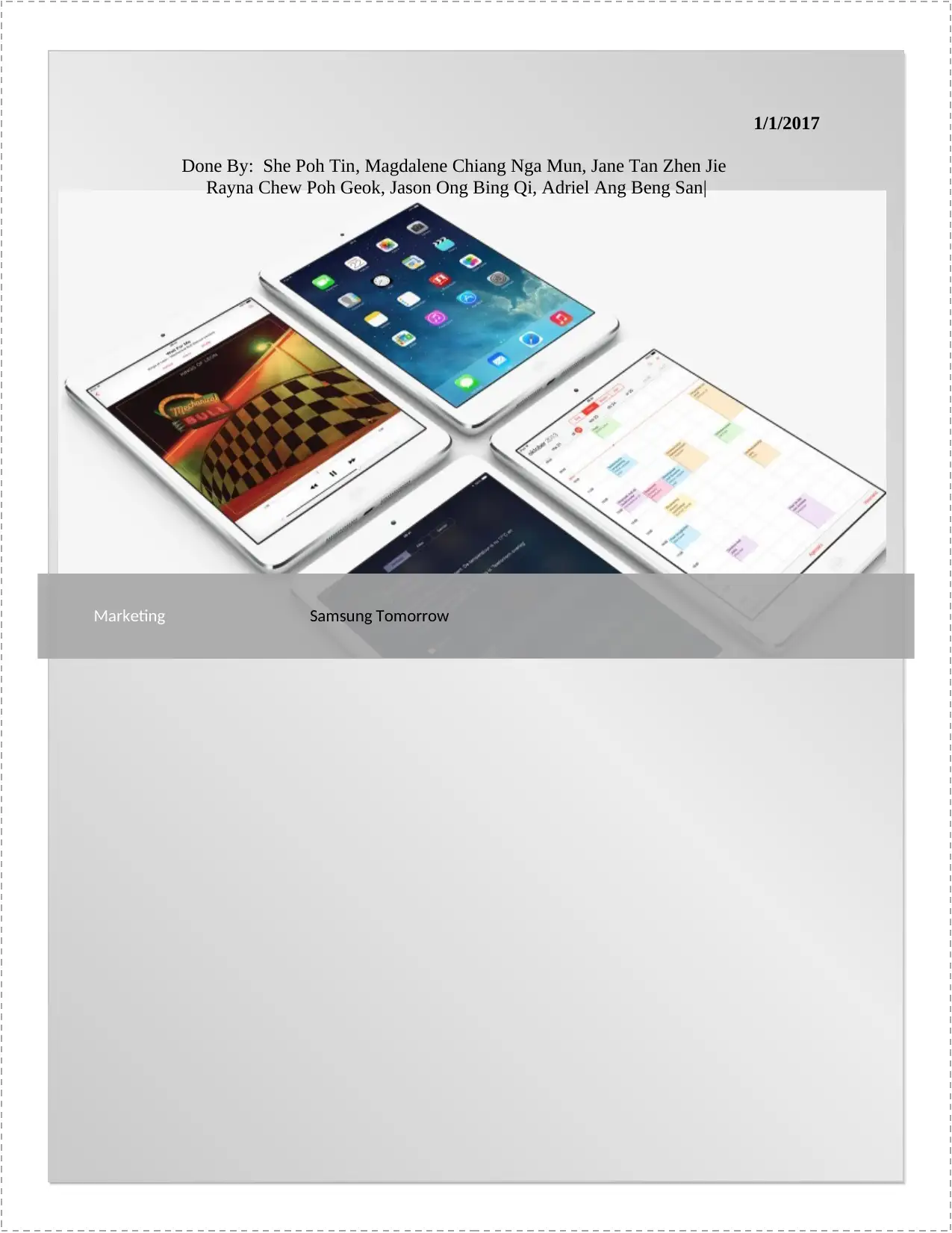
1/1/2017
Done By: She Poh Tin, Magdalene Chiang Nga Mun, Jane Tan Zhen Jie
Rayna Chew Poh Geok, Jason Ong Bing Qi, Adriel Ang Beng San|
Marketing Samsung Tomorrow
Done By: She Poh Tin, Magdalene Chiang Nga Mun, Jane Tan Zhen Jie
Rayna Chew Poh Geok, Jason Ong Bing Qi, Adriel Ang Beng San|
Marketing Samsung Tomorrow
Paraphrase This Document
Need a fresh take? Get an instant paraphrase of this document with our AI Paraphraser
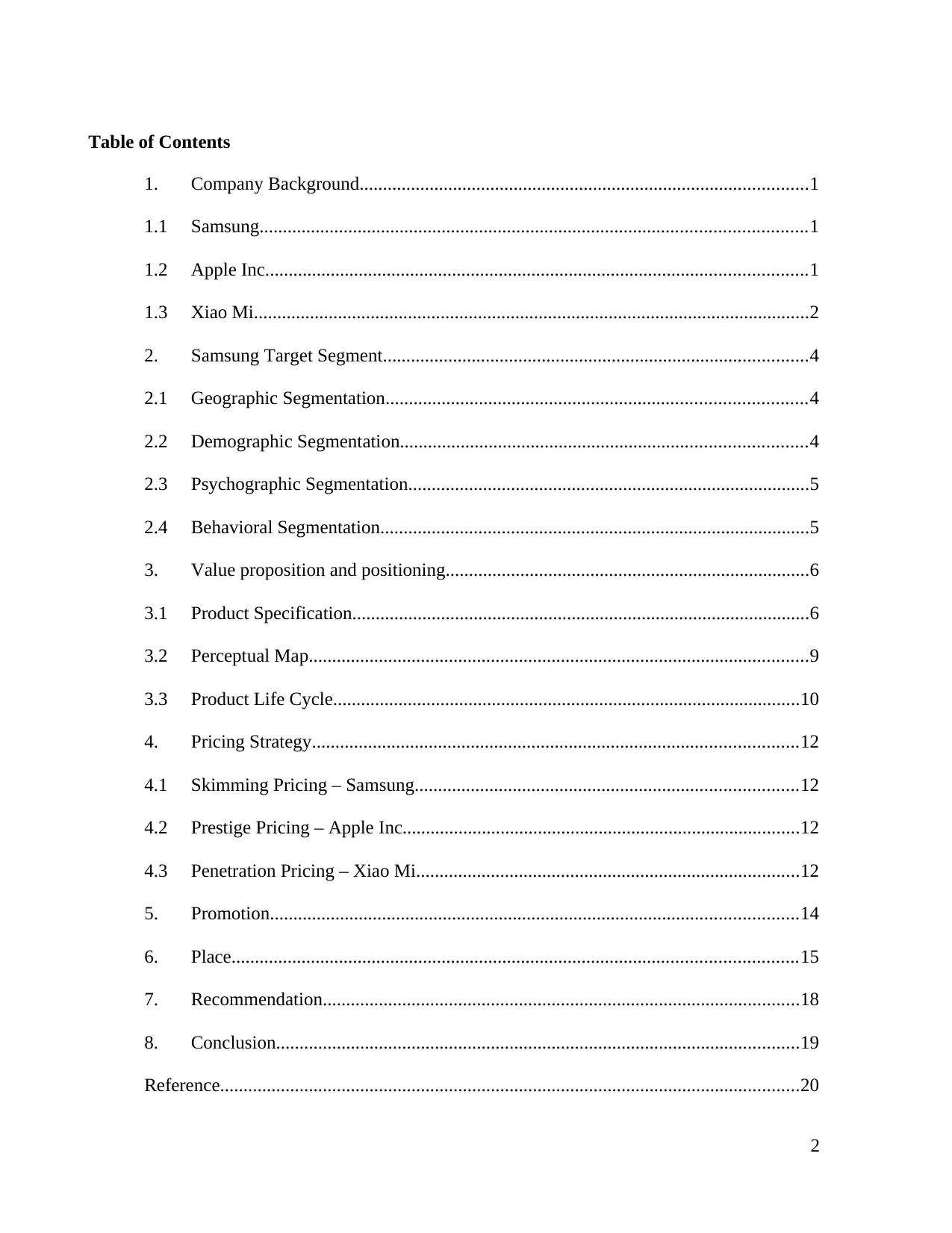
Table of Contents
1. Company Background................................................................................................1
1.1 Samsung.....................................................................................................................1
1.2 Apple Inc....................................................................................................................1
1.3 Xiao Mi.......................................................................................................................2
2. Samsung Target Segment...........................................................................................4
2.1 Geographic Segmentation..........................................................................................4
2.2 Demographic Segmentation.......................................................................................4
2.3 Psychographic Segmentation......................................................................................5
2.4 Behavioral Segmentation............................................................................................5
3. Value proposition and positioning..............................................................................6
3.1 Product Specification..................................................................................................6
3.2 Perceptual Map...........................................................................................................9
3.3 Product Life Cycle....................................................................................................10
4. Pricing Strategy........................................................................................................12
4.1 Skimming Pricing – Samsung..................................................................................12
4.2 Prestige Pricing – Apple Inc.....................................................................................12
4.3 Penetration Pricing – Xiao Mi..................................................................................12
5. Promotion.................................................................................................................14
6. Place.........................................................................................................................15
7. Recommendation......................................................................................................18
8. Conclusion................................................................................................................19
Reference............................................................................................................................20
2
1. Company Background................................................................................................1
1.1 Samsung.....................................................................................................................1
1.2 Apple Inc....................................................................................................................1
1.3 Xiao Mi.......................................................................................................................2
2. Samsung Target Segment...........................................................................................4
2.1 Geographic Segmentation..........................................................................................4
2.2 Demographic Segmentation.......................................................................................4
2.3 Psychographic Segmentation......................................................................................5
2.4 Behavioral Segmentation............................................................................................5
3. Value proposition and positioning..............................................................................6
3.1 Product Specification..................................................................................................6
3.2 Perceptual Map...........................................................................................................9
3.3 Product Life Cycle....................................................................................................10
4. Pricing Strategy........................................................................................................12
4.1 Skimming Pricing – Samsung..................................................................................12
4.2 Prestige Pricing – Apple Inc.....................................................................................12
4.3 Penetration Pricing – Xiao Mi..................................................................................12
5. Promotion.................................................................................................................14
6. Place.........................................................................................................................15
7. Recommendation......................................................................................................18
8. Conclusion................................................................................................................19
Reference............................................................................................................................20
2
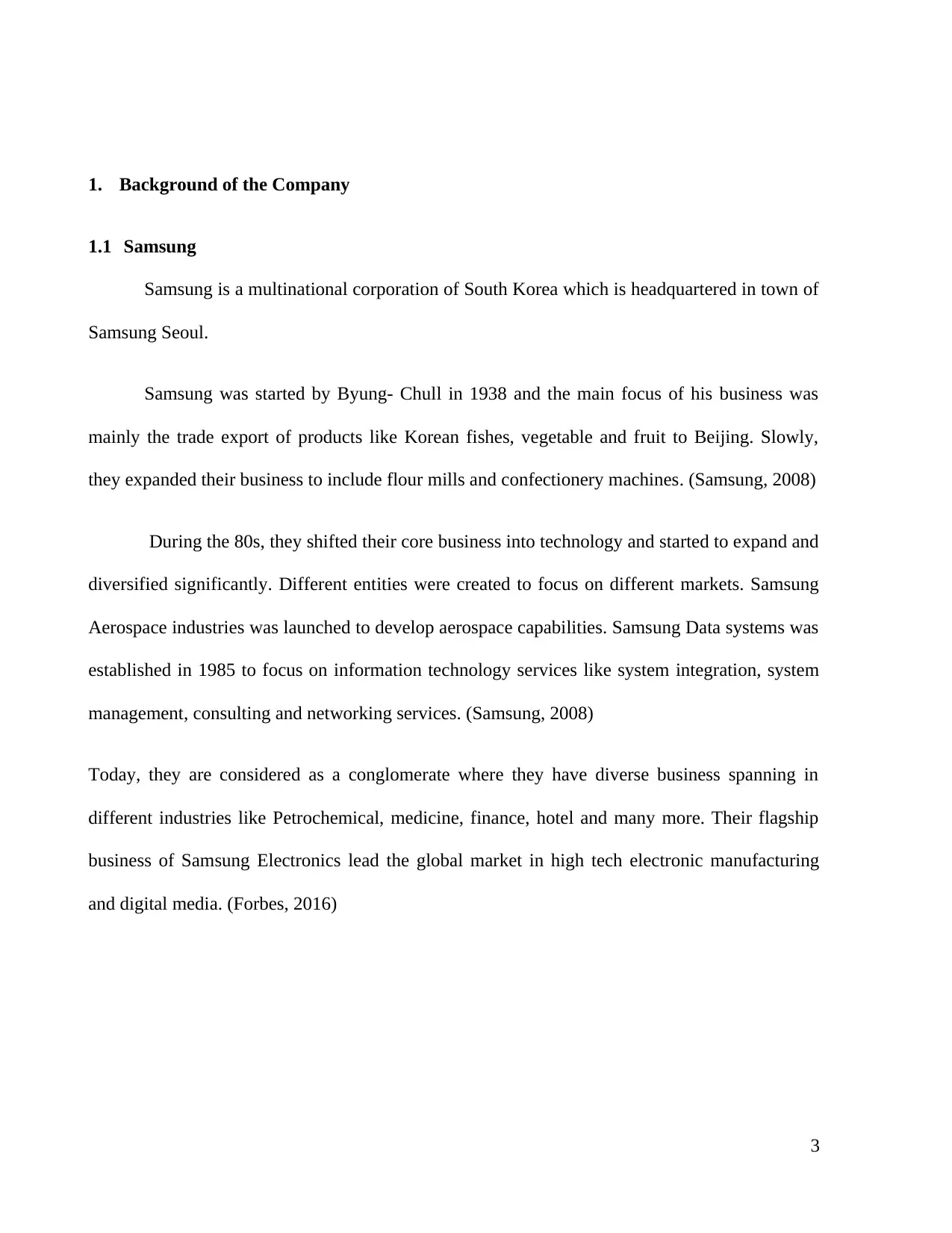
1. Background of the Company
1.1 Samsung
Samsung is a multinational corporation of South Korea which is headquartered in town of
Samsung Seoul.
Samsung was started by Byung- Chull in 1938 and the main focus of his business was
mainly the trade export of products like Korean fishes, vegetable and fruit to Beijing. Slowly,
they expanded their business to include flour mills and confectionery machines. (Samsung, 2008)
During the 80s, they shifted their core business into technology and started to expand and
diversified significantly. Different entities were created to focus on different markets. Samsung
Aerospace industries was launched to develop aerospace capabilities. Samsung Data systems was
established in 1985 to focus on information technology services like system integration, system
management, consulting and networking services. (Samsung, 2008)
Today, they are considered as a conglomerate where they have diverse business spanning in
different industries like Petrochemical, medicine, finance, hotel and many more. Their flagship
business of Samsung Electronics lead the global market in high tech electronic manufacturing
and digital media. (Forbes, 2016)
3
1.1 Samsung
Samsung is a multinational corporation of South Korea which is headquartered in town of
Samsung Seoul.
Samsung was started by Byung- Chull in 1938 and the main focus of his business was
mainly the trade export of products like Korean fishes, vegetable and fruit to Beijing. Slowly,
they expanded their business to include flour mills and confectionery machines. (Samsung, 2008)
During the 80s, they shifted their core business into technology and started to expand and
diversified significantly. Different entities were created to focus on different markets. Samsung
Aerospace industries was launched to develop aerospace capabilities. Samsung Data systems was
established in 1985 to focus on information technology services like system integration, system
management, consulting and networking services. (Samsung, 2008)
Today, they are considered as a conglomerate where they have diverse business spanning in
different industries like Petrochemical, medicine, finance, hotel and many more. Their flagship
business of Samsung Electronics lead the global market in high tech electronic manufacturing
and digital media. (Forbes, 2016)
3
⊘ This is a preview!⊘
Do you want full access?
Subscribe today to unlock all pages.

Trusted by 1+ million students worldwide
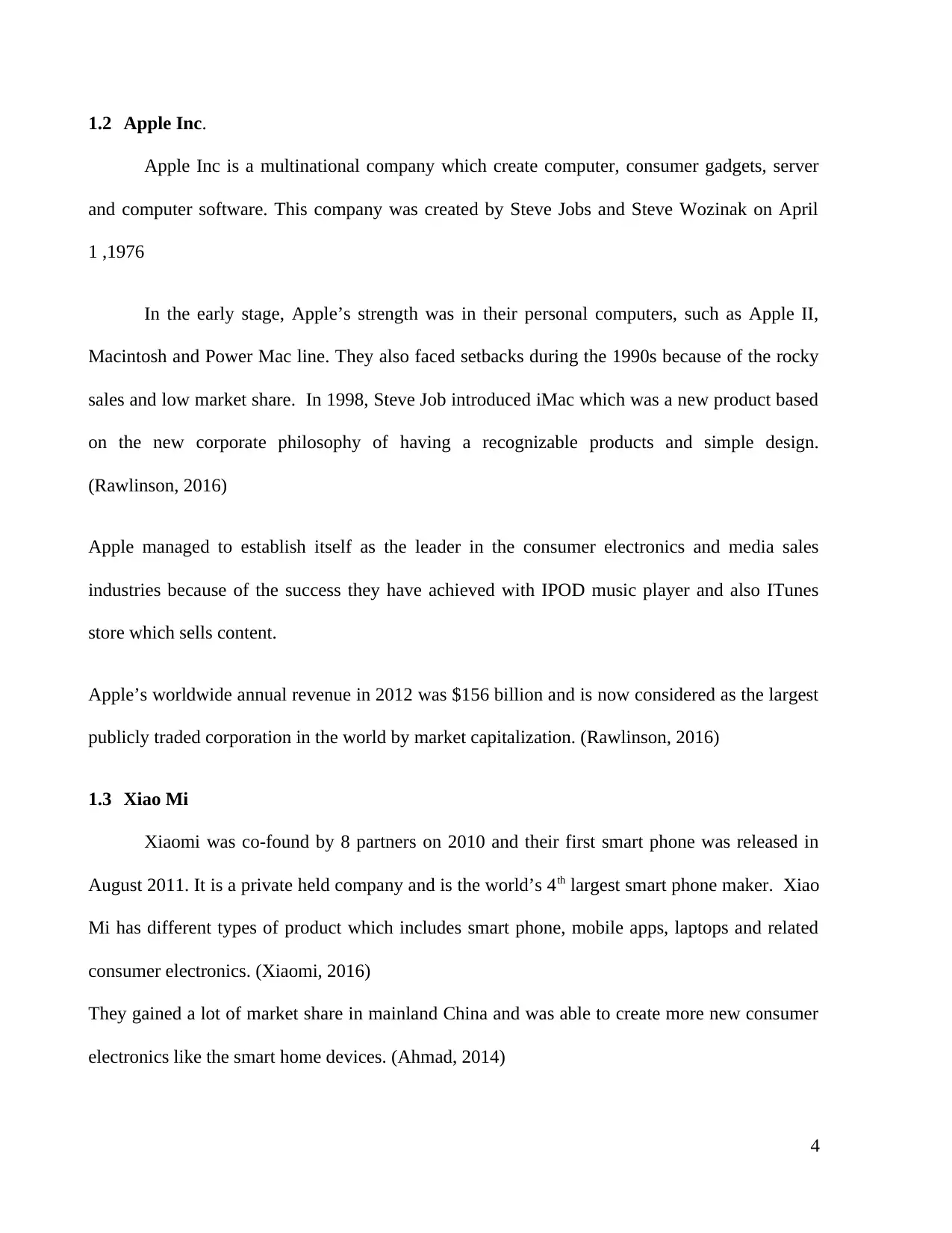
1.2 Apple Inc.
Apple Inc is a multinational company which create computer, consumer gadgets, server
and computer software. This company was created by Steve Jobs and Steve Wozinak on April
1 ,1976
In the early stage, Apple’s strength was in their personal computers, such as Apple II,
Macintosh and Power Mac line. They also faced setbacks during the 1990s because of the rocky
sales and low market share. In 1998, Steve Job introduced iMac which was a new product based
on the new corporate philosophy of having a recognizable products and simple design.
(Rawlinson, 2016)
Apple managed to establish itself as the leader in the consumer electronics and media sales
industries because of the success they have achieved with IPOD music player and also ITunes
store which sells content.
Apple’s worldwide annual revenue in 2012 was $156 billion and is now considered as the largest
publicly traded corporation in the world by market capitalization. (Rawlinson, 2016)
1.3 Xiao Mi
Xiaomi was co-found by 8 partners on 2010 and their first smart phone was released in
August 2011. It is a private held company and is the world’s 4th largest smart phone maker. Xiao
Mi has different types of product which includes smart phone, mobile apps, laptops and related
consumer electronics. (Xiaomi, 2016)
They gained a lot of market share in mainland China and was able to create more new consumer
electronics like the smart home devices. (Ahmad, 2014)
4
Apple Inc is a multinational company which create computer, consumer gadgets, server
and computer software. This company was created by Steve Jobs and Steve Wozinak on April
1 ,1976
In the early stage, Apple’s strength was in their personal computers, such as Apple II,
Macintosh and Power Mac line. They also faced setbacks during the 1990s because of the rocky
sales and low market share. In 1998, Steve Job introduced iMac which was a new product based
on the new corporate philosophy of having a recognizable products and simple design.
(Rawlinson, 2016)
Apple managed to establish itself as the leader in the consumer electronics and media sales
industries because of the success they have achieved with IPOD music player and also ITunes
store which sells content.
Apple’s worldwide annual revenue in 2012 was $156 billion and is now considered as the largest
publicly traded corporation in the world by market capitalization. (Rawlinson, 2016)
1.3 Xiao Mi
Xiaomi was co-found by 8 partners on 2010 and their first smart phone was released in
August 2011. It is a private held company and is the world’s 4th largest smart phone maker. Xiao
Mi has different types of product which includes smart phone, mobile apps, laptops and related
consumer electronics. (Xiaomi, 2016)
They gained a lot of market share in mainland China and was able to create more new consumer
electronics like the smart home devices. (Ahmad, 2014)
4
Paraphrase This Document
Need a fresh take? Get an instant paraphrase of this document with our AI Paraphraser
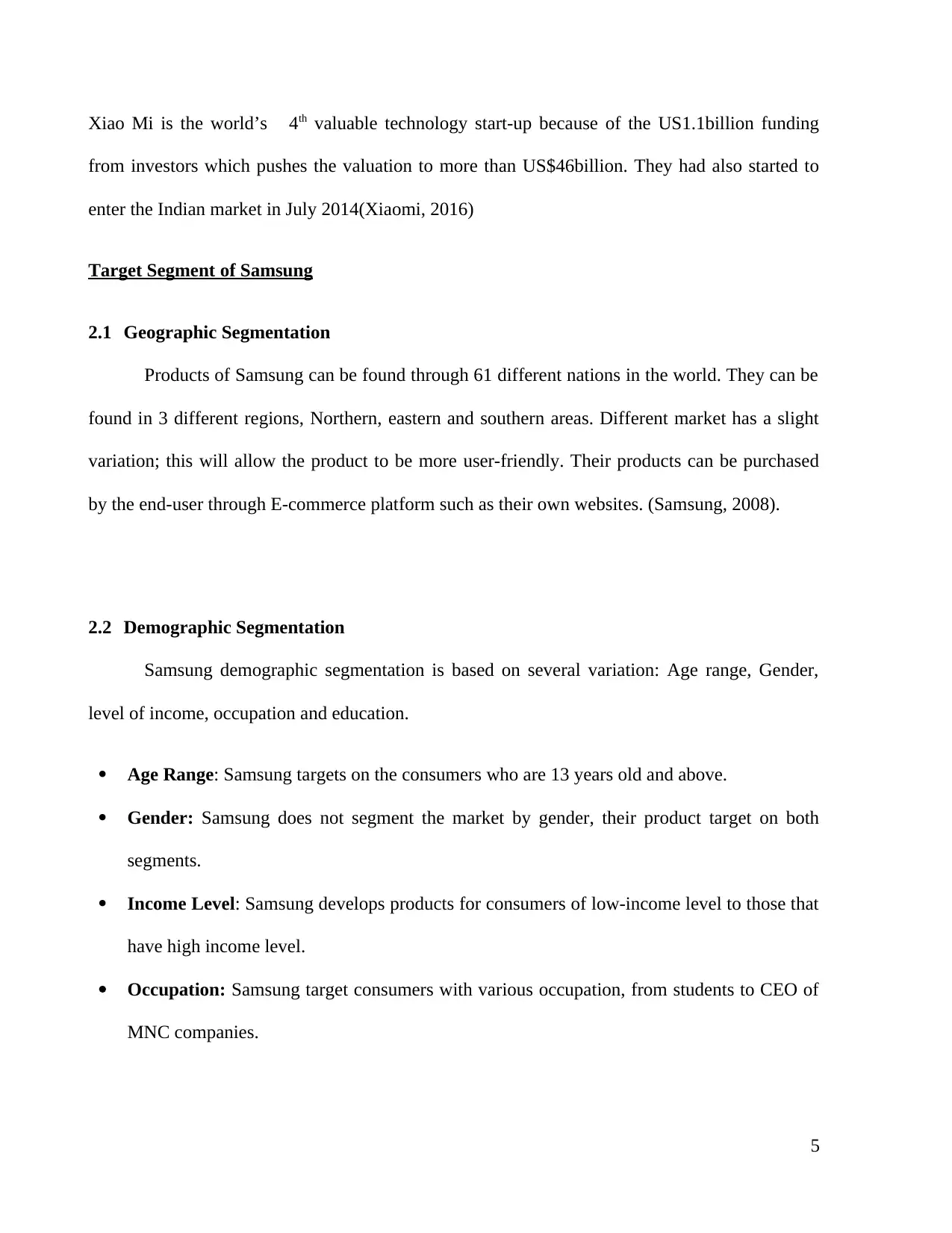
Xiao Mi is the world’s 4th valuable technology start-up because of the US1.1billion funding
from investors which pushes the valuation to more than US$46billion. They had also started to
enter the Indian market in July 2014(Xiaomi, 2016)
Target Segment of Samsung
2.1 Geographic Segmentation
Products of Samsung can be found through 61 different nations in the world. They can be
found in 3 different regions, Northern, eastern and southern areas. Different market has a slight
variation; this will allow the product to be more user-friendly. Their products can be purchased
by the end-user through E-commerce platform such as their own websites. (Samsung, 2008).
2.2 Demographic Segmentation
Samsung demographic segmentation is based on several variation: Age range, Gender,
level of income, occupation and education.
Age Range: Samsung targets on the consumers who are 13 years old and above.
Gender: Samsung does not segment the market by gender, their product target on both
segments.
Income Level: Samsung develops products for consumers of low-income level to those that
have high income level.
Occupation: Samsung target consumers with various occupation, from students to CEO of
MNC companies.
5
from investors which pushes the valuation to more than US$46billion. They had also started to
enter the Indian market in July 2014(Xiaomi, 2016)
Target Segment of Samsung
2.1 Geographic Segmentation
Products of Samsung can be found through 61 different nations in the world. They can be
found in 3 different regions, Northern, eastern and southern areas. Different market has a slight
variation; this will allow the product to be more user-friendly. Their products can be purchased
by the end-user through E-commerce platform such as their own websites. (Samsung, 2008).
2.2 Demographic Segmentation
Samsung demographic segmentation is based on several variation: Age range, Gender,
level of income, occupation and education.
Age Range: Samsung targets on the consumers who are 13 years old and above.
Gender: Samsung does not segment the market by gender, their product target on both
segments.
Income Level: Samsung develops products for consumers of low-income level to those that
have high income level.
Occupation: Samsung target consumers with various occupation, from students to CEO of
MNC companies.
5
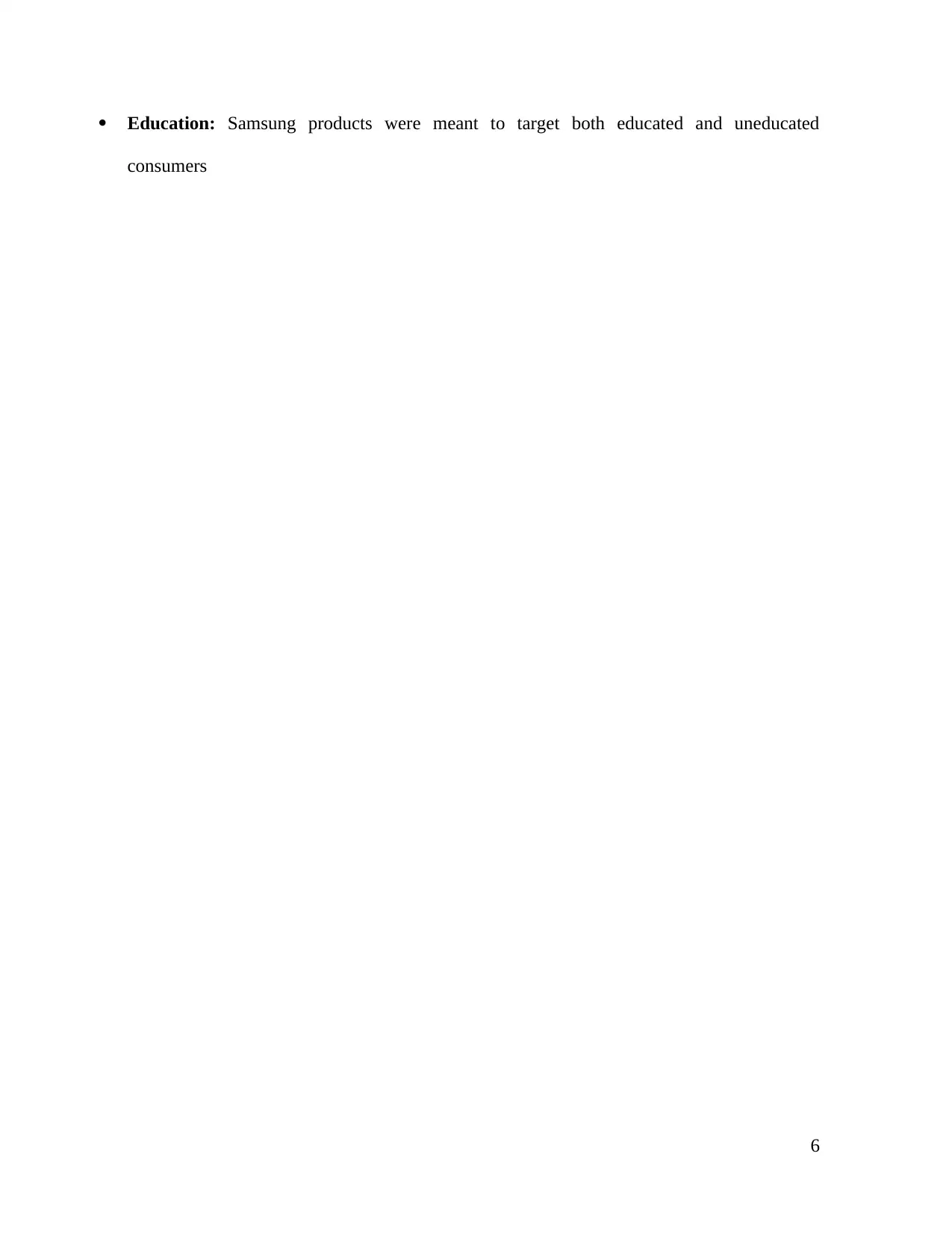
Education: Samsung products were meant to target both educated and uneducated
consumers
6
consumers
6
⊘ This is a preview!⊘
Do you want full access?
Subscribe today to unlock all pages.

Trusted by 1+ million students worldwide
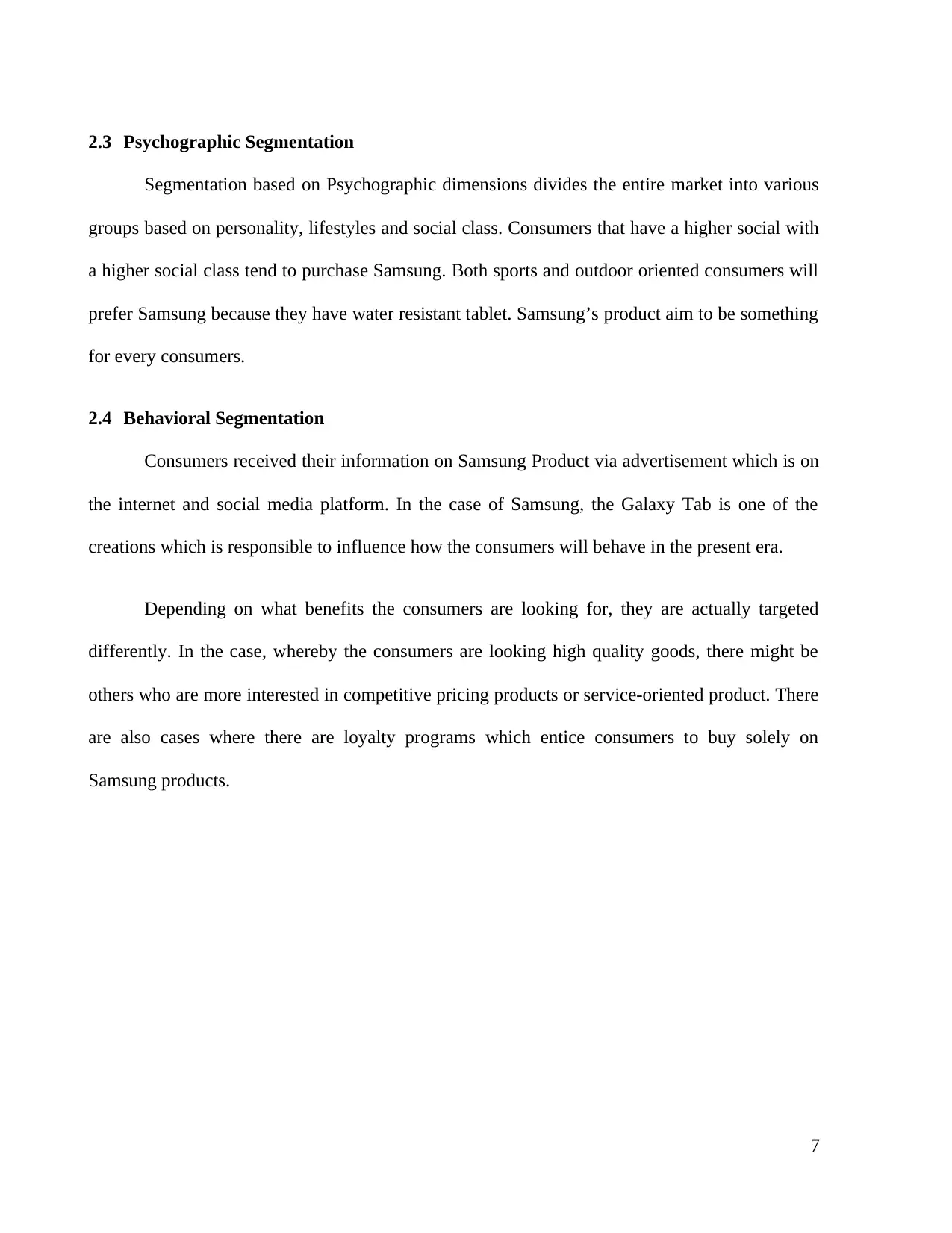
2.3 Psychographic Segmentation
Segmentation based on Psychographic dimensions divides the entire market into various
groups based on personality, lifestyles and social class. Consumers that have a higher social with
a higher social class tend to purchase Samsung. Both sports and outdoor oriented consumers will
prefer Samsung because they have water resistant tablet. Samsung’s product aim to be something
for every consumers.
2.4 Behavioral Segmentation
Consumers received their information on Samsung Product via advertisement which is on
the internet and social media platform. In the case of Samsung, the Galaxy Tab is one of the
creations which is responsible to influence how the consumers will behave in the present era.
Depending on what benefits the consumers are looking for, they are actually targeted
differently. In the case, whereby the consumers are looking high quality goods, there might be
others who are more interested in competitive pricing products or service-oriented product. There
are also cases where there are loyalty programs which entice consumers to buy solely on
Samsung products.
7
Segmentation based on Psychographic dimensions divides the entire market into various
groups based on personality, lifestyles and social class. Consumers that have a higher social with
a higher social class tend to purchase Samsung. Both sports and outdoor oriented consumers will
prefer Samsung because they have water resistant tablet. Samsung’s product aim to be something
for every consumers.
2.4 Behavioral Segmentation
Consumers received their information on Samsung Product via advertisement which is on
the internet and social media platform. In the case of Samsung, the Galaxy Tab is one of the
creations which is responsible to influence how the consumers will behave in the present era.
Depending on what benefits the consumers are looking for, they are actually targeted
differently. In the case, whereby the consumers are looking high quality goods, there might be
others who are more interested in competitive pricing products or service-oriented product. There
are also cases where there are loyalty programs which entice consumers to buy solely on
Samsung products.
7
Paraphrase This Document
Need a fresh take? Get an instant paraphrase of this document with our AI Paraphraser
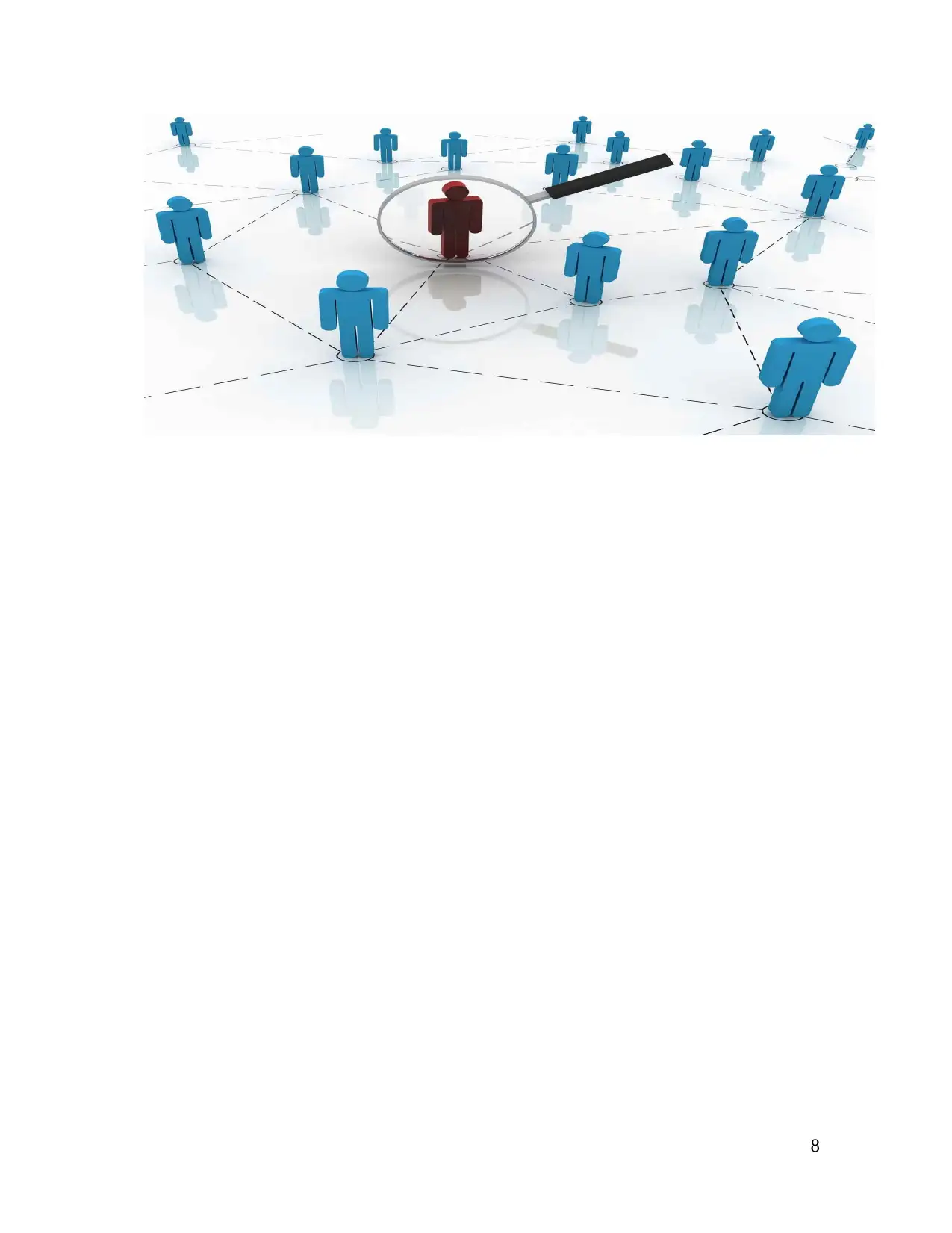
8
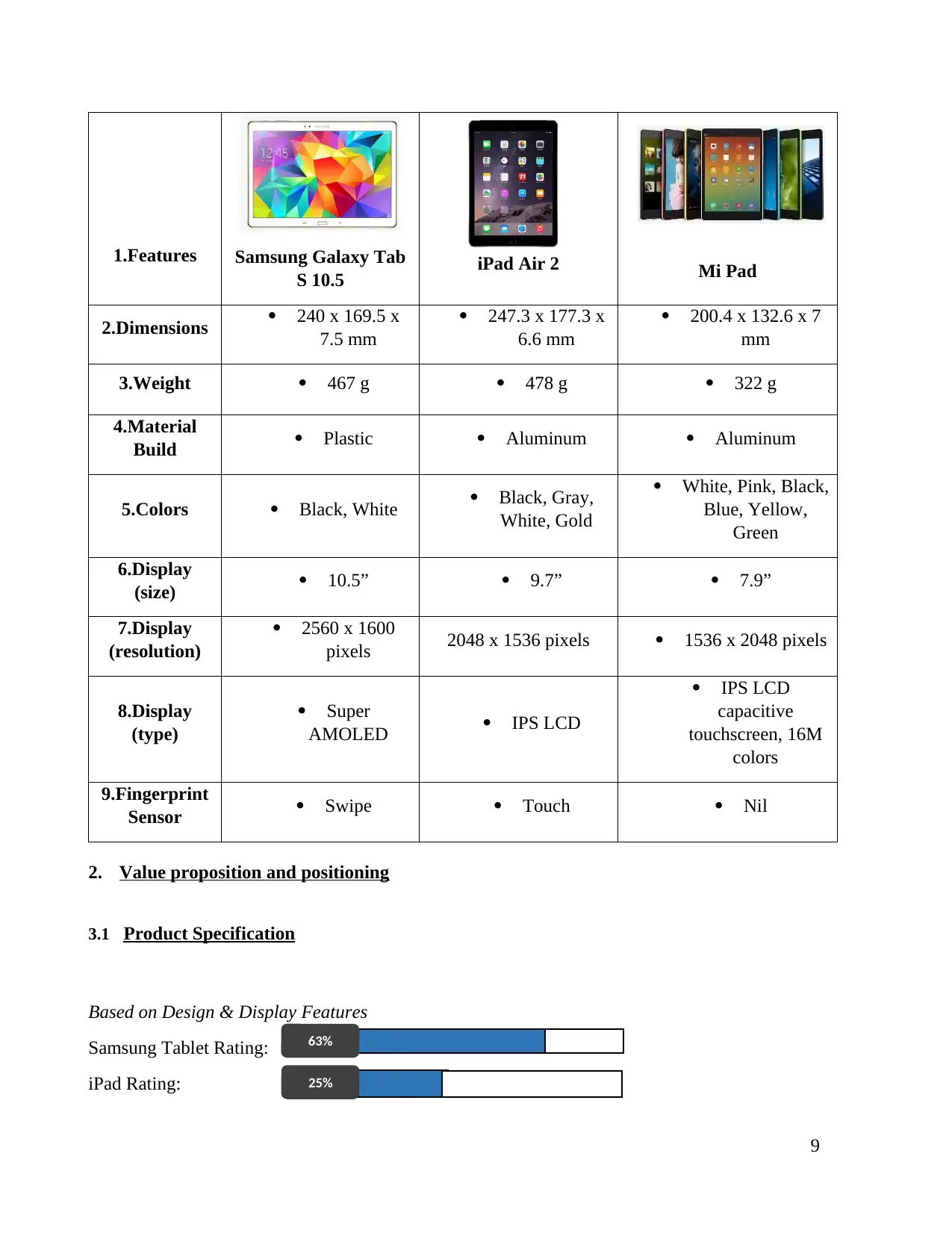
1.Features Samsung Galaxy Tab
S 10.5 iPad Air 2 Mi Pad
2.Dimensions 240 x 169.5 x
7.5 mm
247.3 x 177.3 x
6.6 mm
200.4 x 132.6 x 7
mm
3.Weight 467 g 478 g 322 g
4.Material
Build Plastic Aluminum Aluminum
5.Colors Black, White Black, Gray,
White, Gold
White, Pink, Black,
Blue, Yellow,
Green
6.Display
(size) 10.5” 9.7” 7.9”
7.Display
(resolution)
2560 x 1600
pixels 2048 x 1536 pixels 1536 x 2048 pixels
8.Display
(type)
Super
AMOLED IPS LCD
IPS LCD
capacitive
touchscreen, 16M
colors
9.Fingerprint
Sensor Swipe Touch Nil
2. Value proposition and positioning
3.1 Product Specification
Based on Design & Display Features
Samsung Tablet Rating:
iPad Rating:
9
63%
25%
S 10.5 iPad Air 2 Mi Pad
2.Dimensions 240 x 169.5 x
7.5 mm
247.3 x 177.3 x
6.6 mm
200.4 x 132.6 x 7
mm
3.Weight 467 g 478 g 322 g
4.Material
Build Plastic Aluminum Aluminum
5.Colors Black, White Black, Gray,
White, Gold
White, Pink, Black,
Blue, Yellow,
Green
6.Display
(size) 10.5” 9.7” 7.9”
7.Display
(resolution)
2560 x 1600
pixels 2048 x 1536 pixels 1536 x 2048 pixels
8.Display
(type)
Super
AMOLED IPS LCD
IPS LCD
capacitive
touchscreen, 16M
colors
9.Fingerprint
Sensor Swipe Touch Nil
2. Value proposition and positioning
3.1 Product Specification
Based on Design & Display Features
Samsung Tablet Rating:
iPad Rating:
9
63%
25%
⊘ This is a preview!⊘
Do you want full access?
Subscribe today to unlock all pages.

Trusted by 1+ million students worldwide
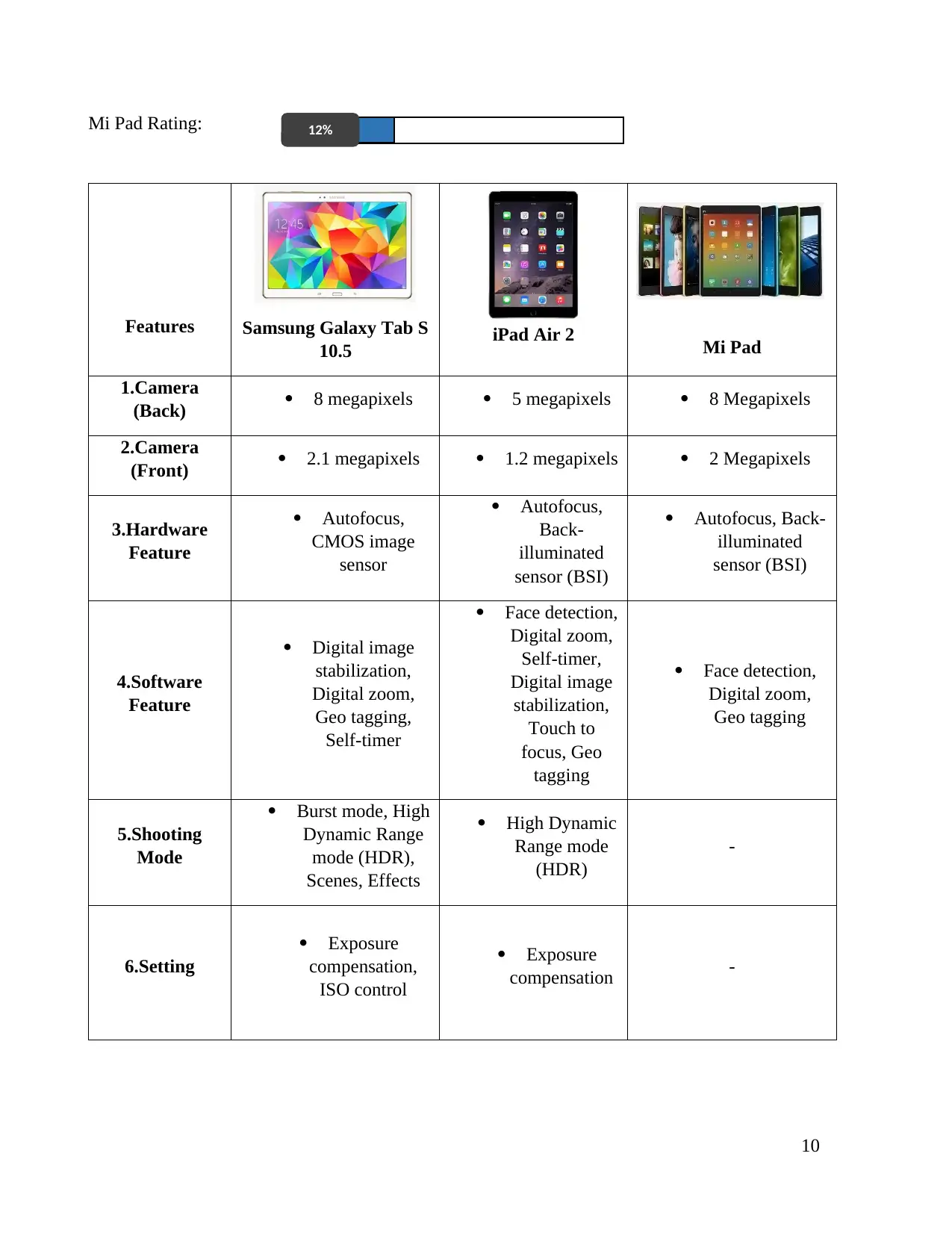
Mi Pad Rating:
Features Samsung Galaxy Tab S
10.5 iPad Air 2 Mi Pad
1.Camera
(Back) 8 megapixels 5 megapixels 8 Megapixels
2.Camera
(Front) 2.1 megapixels 1.2 megapixels 2 Megapixels
3.Hardware
Feature
Autofocus,
CMOS image
sensor
Autofocus,
Back-
illuminated
sensor (BSI)
Autofocus, Back-
illuminated
sensor (BSI)
4.Software
Feature
Digital image
stabilization,
Digital zoom,
Geo tagging,
Self-timer
Face detection,
Digital zoom,
Self-timer,
Digital image
stabilization,
Touch to
focus, Geo
tagging
Face detection,
Digital zoom,
Geo tagging
5.Shooting
Mode
Burst mode, High
Dynamic Range
mode (HDR),
Scenes, Effects
High Dynamic
Range mode
(HDR)
-
6.Setting
Exposure
compensation,
ISO control
Exposure
compensation -
10
12%
Features Samsung Galaxy Tab S
10.5 iPad Air 2 Mi Pad
1.Camera
(Back) 8 megapixels 5 megapixels 8 Megapixels
2.Camera
(Front) 2.1 megapixels 1.2 megapixels 2 Megapixels
3.Hardware
Feature
Autofocus,
CMOS image
sensor
Autofocus,
Back-
illuminated
sensor (BSI)
Autofocus, Back-
illuminated
sensor (BSI)
4.Software
Feature
Digital image
stabilization,
Digital zoom,
Geo tagging,
Self-timer
Face detection,
Digital zoom,
Self-timer,
Digital image
stabilization,
Touch to
focus, Geo
tagging
Face detection,
Digital zoom,
Geo tagging
5.Shooting
Mode
Burst mode, High
Dynamic Range
mode (HDR),
Scenes, Effects
High Dynamic
Range mode
(HDR)
-
6.Setting
Exposure
compensation,
ISO control
Exposure
compensation -
10
12%
Paraphrase This Document
Need a fresh take? Get an instant paraphrase of this document with our AI Paraphraser
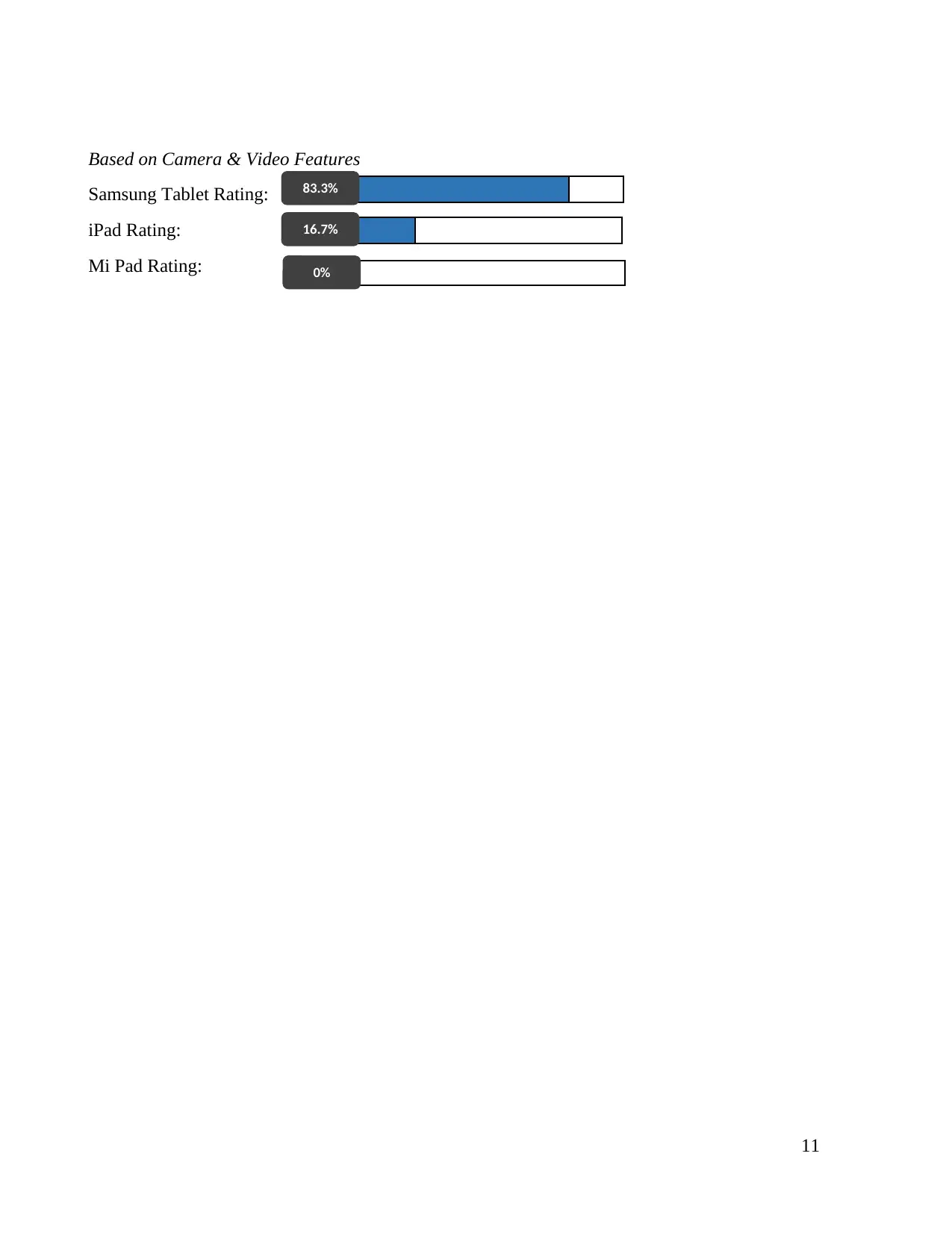
Based on Camera & Video Features
Samsung Tablet Rating:
iPad Rating:
Mi Pad Rating:
11
16.7%
0%
83.3%
Samsung Tablet Rating:
iPad Rating:
Mi Pad Rating:
11
16.7%
0%
83.3%
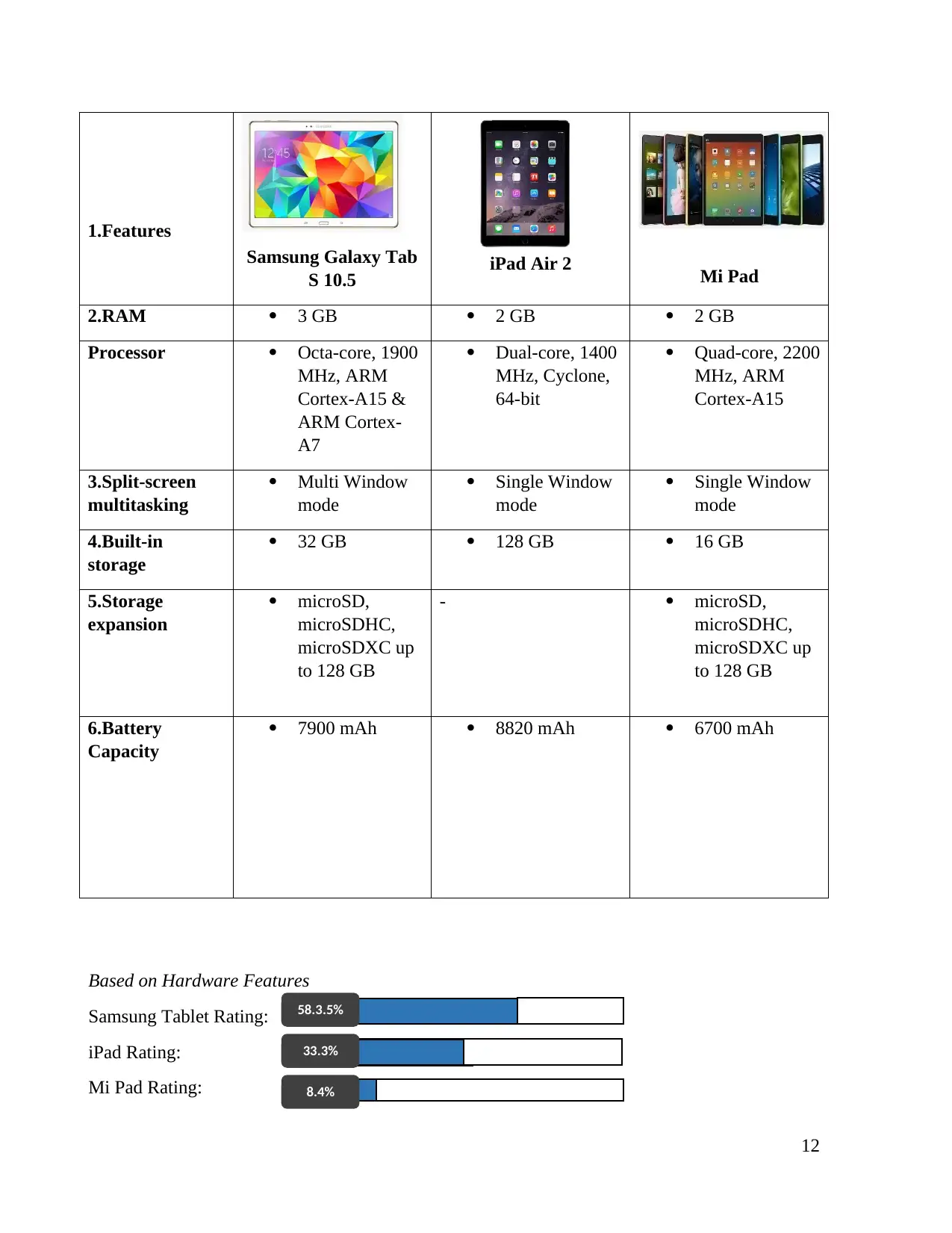
1.Features
Samsung Galaxy Tab
S 10.5 iPad Air 2 Mi Pad
2.RAM 3 GB 2 GB 2 GB
Processor Octa-core, 1900
MHz, ARM
Cortex-A15 &
ARM Cortex-
A7
Dual-core, 1400
MHz, Cyclone,
64-bit
Quad-core, 2200
MHz, ARM
Cortex-A15
3.Split-screen
multitasking
Multi Window
mode
Single Window
mode
Single Window
mode
4.Built-in
storage
32 GB 128 GB 16 GB
5.Storage
expansion
microSD,
microSDHC,
microSDXC up
to 128 GB
- microSD,
microSDHC,
microSDXC up
to 128 GB
6.Battery
Capacity
7900 mAh 8820 mAh 6700 mAh
Based on Hardware Features
Samsung Tablet Rating:
iPad Rating:
Mi Pad Rating:
12
58.3.5%
33.3%
8.4%
Samsung Galaxy Tab
S 10.5 iPad Air 2 Mi Pad
2.RAM 3 GB 2 GB 2 GB
Processor Octa-core, 1900
MHz, ARM
Cortex-A15 &
ARM Cortex-
A7
Dual-core, 1400
MHz, Cyclone,
64-bit
Quad-core, 2200
MHz, ARM
Cortex-A15
3.Split-screen
multitasking
Multi Window
mode
Single Window
mode
Single Window
mode
4.Built-in
storage
32 GB 128 GB 16 GB
5.Storage
expansion
microSD,
microSDHC,
microSDXC up
to 128 GB
- microSD,
microSDHC,
microSDXC up
to 128 GB
6.Battery
Capacity
7900 mAh 8820 mAh 6700 mAh
Based on Hardware Features
Samsung Tablet Rating:
iPad Rating:
Mi Pad Rating:
12
58.3.5%
33.3%
8.4%
⊘ This is a preview!⊘
Do you want full access?
Subscribe today to unlock all pages.

Trusted by 1+ million students worldwide
1 out of 29
Related Documents
Your All-in-One AI-Powered Toolkit for Academic Success.
+13062052269
info@desklib.com
Available 24*7 on WhatsApp / Email
![[object Object]](/_next/static/media/star-bottom.7253800d.svg)
Unlock your academic potential
Copyright © 2020–2025 A2Z Services. All Rights Reserved. Developed and managed by ZUCOL.





